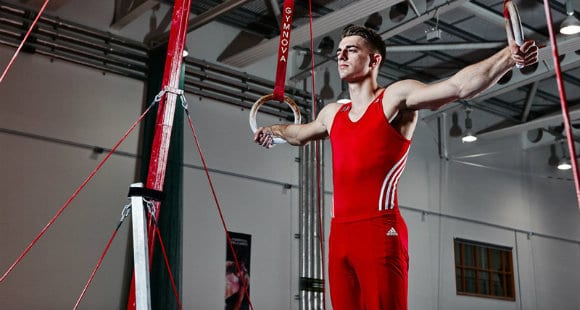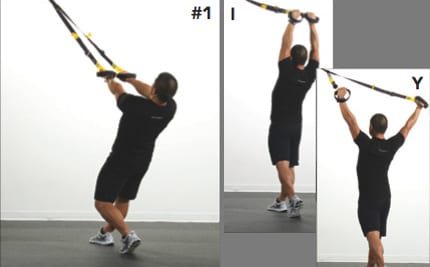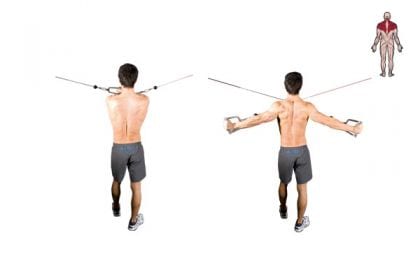By the healthiergang writer , student in Physiotherapy.
Training at the rings
The rings are probably the best tool for training the upper body.
Not only do they allow you to effectively train almost all the muscles of the trunk and arms, this type of training also requires the synergistic work of several muscles both as stabilizers and main authors of the movement.
Another benefit is that the ring allows you to fully respect the joint movement: it is not like a rigid bar that fixes the hands in one position. One of the muscle groups that can benefit most from gymnastic rings are the shoulders and trapezes.
These muscle groups are often "difficult to train" with classic open kinetic chain exercises. Another problem is the risk to which the joints are subjected during these exercises, especially if you are a beginner with weight lifting.

1. Shoulders and trapezes
The shoulder is the region that includes at least 4 joints and connects the upper limb to the trunk.
This joint is the most mobile in the whole body, both for the morphology and for the laxity of the ligaments, and is consequently also the least stable.
There are numerous muscles that move this joint but when we talk about shoulder training we often refer to the deltoids.
These are certainly the protagonists of a shoulder training but if you want to preserve health (and therefore if you want to continue training for a long time) you must necessarily take into account the rotator cuff muscles.
These muscles literally envelop the head of the humerus in the glenoid cavity and allow it to be kept centered in this during the various movements that the shoulder makes.
A strong rotator cuff results in a healthy, stable, and strong shoulder (with direct benefit on major exercises such as bench press and over head press).
Trapezes also take part in shoulder training: the upper bundle turns out to be an unwanted aid that occurs in an attempt to train the central deltoid while the middle bundle and especially the lower one are often not really taken into account.
This is a big deal because all shoulder problems have a cause in the scapula and often precisely because certain muscles are too weak and cannot perform their function. Once again a good development of medium and low trapezoids results in a healthy, stable and stronger joint.
2. Anterior deltoid
The deltoid muscle is made up of 3 bundles: one anterior, one posterior and one central.
Depending on the orientation in the space assumed by the movement of the shoulder, one beam is favored over another.
For a muscle to be trained it is necessary to use this muscle for the functions it performs.
It is therefore necessary to find those exercises that allow you to recruit a muscle in the completeness of its actions without going to jeopardize the joint.
The anterior bundle participates in flexion and intra rotation of the humerus. Looking at this feature it is easy to understand how this muscle is already strongly stimulated in most of the pushing movements, so much so that it often hinders the recruitment of other muscles such as the pectorals.
Having said that, the need to further train this muscle does not arise, but this does not mean that you can have benefits in doing so. Training a muscle directly allows a greater development of this and makes you acquire a greater awareness of this muscle.
A good exercise for train the anterior bundle of the deltoid with rings could be as follows.
- Holding on to the rings, position yourself with the entire rigid body and form an angle with the floor.
- The more you move parallel to the ground, the more difficult the exercise becomes.
- The arms must be kept straight in front of you without forcing their position but the grip must be supine.
- From this position retract the shoulder blades and lower them looking for a contraction in the middle and lower trapezius muscles.
- From this position, keeping the elbows straight, bring your arms upwards by applying force on the rings and imagining to carry them up behind the head.
- While performing this movement, rotate the whole arm bringing the hand to a neutral position as well (hammer grip).
- From there, keep the contraction for a second or two and control the movement by returning to the initial phase.
3. Central deltoid
The central deltoid is the muscle bundle primarily responsible for shoulder width. However, it is often difficult to train this muscle adequately due to the interference of the upper trapezius.
This suggests that both of these muscles have a similar if not similar function. The central deltoid participates in shoulder abduction, as does the upper trapezius.
Shoulder abduction, however, is a movement that describes (at least it should) 180 degrees, a very large portion of movement.
In fact, the lateral deltoid participates more in the first half of the movement, up to just above 90 degrees and gradually the upper trapezius comes into play as it has a mechanical advantage.
However, what also characterizes the upper trapezius is the elevation of the shoulder blades. to further isolate the work on the central deltoid it is therefore useful to lower the shoulder blades and imagine pushing outwards.
This guarantees an inhibition of this muscle, greatly favoring the central deltoid. It is therefore necessary to greatly privilege the technique to the intensity of the exercise and therefore it is necessary to use a difficulty that is congruent with one's abilities.
The exercise that is most suitable for central deltoid training is the reverse fly with raised arms.
- Starting in the same position, but this time with a neutral grip, from the previous exercise begin with a lowering and retraction of the shoulder blades.
- From here, force on the rings by bringing your arms behind you but forward, at an angle of more than 90 degrees.
- When doing this movement, you need to focus on bringing your arms outward and contracting the central deltoid. It is also useful to add extra arm rotation.
- Maintain the position of maximum contraction for one or two seconds and check the eccentric phase.

4. Posterior deltoid
The posterior deltoid is the bundle which is located in the dorsum of the shoulder and helps to give a full and spherical appearance to the shoulder. It is also a very important muscle in posture and often does not get the proper training it deserves.
Its function is to extend the shoulder and extra rotate it.
The best exercise to train the posterior deltoid will therefore be the reverse crosses.
- Starting in the same position (with the body rigid and inclined with respect to the ground and with the arms forward) and keeping the grip neutral (palms facing each other) force on the rings bringing them to the sides and then behind the body.
- The direction in which you pull must be slightly lower than the height of the shoulders.
- Also in this case the movement is started with a retraction and a lowering of the shoulders and an extra rotation of the arms.
- Maintain the position of maximum contraction for one or two seconds and check the eccentric phase.

Training
These proposed exercises allow you to fully train the 3 bundles of the deltoid without stressing the joint. Another advantage is that both the medium and low trapezius are involved in all 3 exercises.
Particularly in the front deltoid exercise you should feel some important work from the lower trapezius bundle (when the arms are fully elevated and the shoulder blades fully lowered).
Finally, as a last benefit, the 3 muscles that participate in the extra rotation of the shoulder are also involved. All these muscle groups of the shoulder girdle are "made to work in synergy" and therefore the best way to train them is by respecting the way they are made to function. A training proposal could be the following:
- Raises for the lateral deltoid: 3- 4 sets of 10-12 repetitions focusing on the contraction and with a negative phase of 3 seconds. Rest 45-60 seconds
- Raises for the posterior deltoid: 3- 4 sets of 10- 123 repetitions focusing on the contraction and with a negative phase of 3 seconds. Rest 45-60 seconds
- Raises for the front deltoid: 2- 3 sets of 10-12 repetitions focusing on the contraction and with a negative phase of 3 seconds. Rest 45-60 seconds.
- This routine should take 20 minutes or 25 at the most and can be done anywhere.
All you need are a couple of gymnastic rings and a rigid support to attach them to. This routine can replace the entire shoulder workout and can be done 1 to 2 times a week.


























